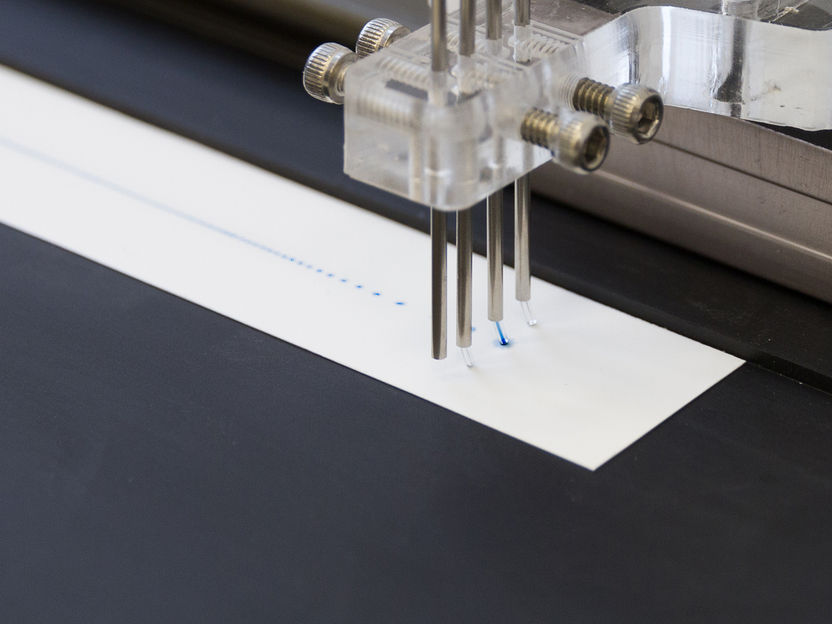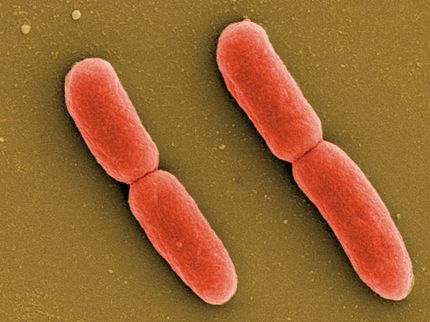Rapid test identifies disease pathogens
Researchers developing a test which rapidly and cost-effectively identifies bacteria, fungi or viruses
Advertisement
At present, bacteria, fungi or viruses can generally only be detected with certainty by way of elaborate laboratory tests or animal experiments. The food and pharmaceutical industries would like to have faster tests to check their products. Fraunhofer researchers are therefore developing a stick that works like a pregnancy test and quickly delivers a result. In the future, it is also to be used for detecting allergens and disease pathogens in the blood.

Production of ImmuStick: Application of immune receptors onto the test strip.
© Foto Fraunhofer IGB
Researchers at the Fraunhofer Institute for Interfacial Engineering and Biotechnology IGB in Stuttgart are developing a test which rapidly and cost-effectively identifies bacteria, fungi or viruses. It can be carried out directly in situ without laboratory equipment and specialist knowledge. “The ImmuStick can even detect pathogens outside the body – on medical devices or in hospital rooms for example. However, the technology would certainly also be of interest for testing human blood for germs or allergies“, says Dr. Anke Burger-Kentischer.
As easy as a pregnancy test
The method works as simply as a pregnancy test. The ImmuStick is a test strip onto which a few drops of fluid are applied. If the fluid contains pyrogens, fragments of pathogens, this is shown by a colored strip in a viewing window. First of all, human immune receptors sensitive to certain pyrogens are applied to the surface of the stick. These are laboratory-produced immune receptors which are synthesized on the basis of the biological model. During production, at the docking point of the immune receptors to which the pyrogens normally bind, a type of placeholder is mounted which is marked with a dye. When drops of a fluid containing pyrogens are then applied to the test strip, the pyrogens rush to the docking point on the immune receptor. The placeholders marked with the dye migrate with the fluid through the test strip until they are visible in the viewing window. The color signal thus indicates that pyrogens that have docked on the immune receptors are present.
The ImmuStick project was financed with money from the Discover program. In this way the Fraunhofer-Gesellschaft is supporting projects for the duration of one year in order to demonstrate the feasibility of a technology. The ImmuStick has passed this test. “We were able to show that it works very well for the bacterial pyrogen LPS. Together with industrial partners, we now want to develop it into a product“, says project manager Burger-Kentischer. “We are currently testing further immune receptors that are specific for other pyrogens.“
Detecting blood poisoning and allergies
Currently envisaged are applications in the food and pharmaceuticals sector or in medical technology, as a complete absence of germs or pyrogens is required there. In principle, the ImmuStick would also be of interest for blood analysis. Pyrogens in the blood often lead to blood poisoning, sepsis, from which many people still die today, especially weakened intensive care patients. “However, blood is a special challenge as it is complex and contains many constituent parts. But in the medium term we are aiming at blood analysis“, says Burger-Kentischer.
As pyrogens also include certain allergy trigger factors, an application here would also be conceivable. In the food and pharmaceutical industries, for example, it is important that products are free of allergens. With the ImmuStick these could be detected quickly, cost-effectively and simply. Costly and laborious laboratory tests would therefore no longer be needed or could be supplemented. At present the IGB researchers are seeking cooperation partners who want to further develop the ImmuStick to make it ready for the market.
Pyrogens become a problem when hygiene is of particular importance – in the food and pharmaceutical industries for example, or on intensive care wards in hospitals. Especially people with weakened immune systems can become severely ill. For this reason, tests are frequently carried out and the surfaces of machines or medical devices are tested for pyrogens using swabs. However, to date these tests have been costly and laborious as pyrogens can only be detected with laboratory equipment. A widely used standard test is the detection of LPS, a structure that is present in the membrane of certain bacteria. At present this test takes up around two hours. Other pyrogens can even only be detected in animal experiment.



























































